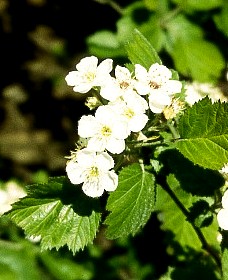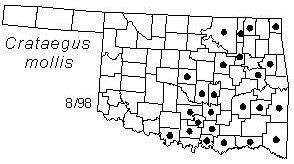
Tree to 12 m (40 ft) tall and 30 cm (12 in) in diameter. Crown rounded and open. Bark brown to gray in scaly plates. Twigs gray, covered with dense white hairs when young, becoming glabrous with age; stout spines, 2.5-5 cm (1-2 in) long. Leaves alternate, simple, broadly ovate, 7.5-10 cm (3-4 in) long and 7-8 cm (2.6-3.1 in) wide, both surfaces densely covered with white hair; color dark yellow-green above; cordate at base, acute at apex, margins doubly serrate, shallow lobes often present; petioles stout, glandular pilose. Flowers in corymbs, pilose, numerous, about 2.5 cm (1 in) wide; calyx-tube narrowly obconic, densely tomentose; petals 5, white; styles 4-5; stamens 20 with large anthers; flowers appear from April to May. Fruits pomes, 1.7-2.5 cm (0.7-1 in) diameter, subglobose to oblong; drooping; calyx lobes deciduous, bright red; nutlets 4-5, light brown; fruits mature in September.
Distribution: Alabama, west to Texas and Oklahoma, north to South Dakota and Minnesota, east to Ontario. Scattered to common in Oklahoma.
Habitat: usually bottomland forest.
Comments: Crataegus is from the Greek meaning "flowering thorn"; mollis refers to the soft hairs on the foliage.
Field identification: Downy hawthorn can be identified by its stout stems and soft pubescence.
Food uses: The fruits are edible and are often made into preserves.
Wildlife benefits: In general, the fruits of hawthorn species are eaten by several species of birds. The dense branching pattern provides shelter and nesting habitat for several species of birds.
NWI status: FACU,FACW-.
Distribution in Oklahoma: 
BACK
NEXT
RETURN TO INDEX
Last update: 9/9/99
 Go to Oklahoma Biological Survey Home Page
Go to Oklahoma Biological Survey Home Page
 Disclaimer
Disclaimer